It’s rare that I say “no thanks” to extras on vehicles I review, but I had to ask the rep who recently set me up for a week with the BMW X1 xDrive 28i to remove the BMW-branded roof rack it was equipped with. (I was afraid it might hit the sprinkler pipes that crisscross the ceiling of my condo’s parking garage.)
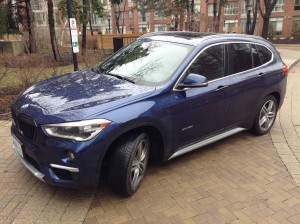
Prompt, courteous attention from both the rep and a colleague brought the box down, and off I drove for my week with the now sportier-looking X1.
First impressions
Devoid of the luggage compartment, my Mediterranean Blue Metallic tester’s dimensions are those of a modern crossover. It strikes a simultaneously sporty and useful pose. The body keeps to BMW’s design language from the (optional) blacked-out twin kidney grille (a detail that prompted a few questions among cognoscenti) to the sloped liftgate.
The 19″ light alloy Y-spoke wheels look a little, well, lightweight on a taller vehicle, but it’s increasingly the look that buyers seem to want. That said, I couldn’t fault the handling.
Interior
Dark sport seats blended with the rest of the sombre Teutonic interior.
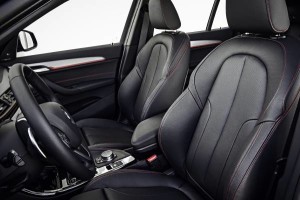
image courtesy BMW
BMW’s optional camera mount was clipped onto the passenger seat headrest posts. It allows a camera-bearing arm to swivel so drivers can point the camera out the front window, or any window they like.
The panorama sunroof stretches to within inches of each side of the X1 and far enough back to let rear-seat passengers gaze at the sky. Speaking of the rear seats, I found them adequately roomy. They move forward so drivers can “stretch” the cargo area without putting seats down.
Small storage spaces in the cockpit reside where you’d expect to find them. Of note, the cupholders sit under sliding covers reminiscent of roll-top desks of old.
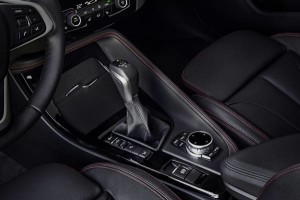
image courtesy BMW
The middle seatback in the rear bench folds down to reveal cupholders and a storage compartment.
Hockey bag test
With the folding rear seats still up, the X1 easily accommodated my bag with room for another of almost the same proportions.

The seats fold 40:20:24, allowing four adult skiers to slide their boards between the rear seats and still fit in the X1. (Many will prefer the roof rack that clips onto the X1’s roof rails.) A power-folding feature enables the rear seats to be folded at the touch of a button inside the luggage compartment.
The power tailgate can be activated by a kicking motion under the rear bumper, though I didn’t manage this maneuver successfully each time I tried it. On those occasions when I had to repeatedly “kick” it softly, onlookers might have thought I was being overly Canadian in expressing anger at the X1.
Thoughtful touch: the base of the open tailgate offers two buttons. The left button closes the tailgate. The right button also closes the tailgate while locking the X1, saving me the trouble of fishing the key fob out of my pocket to do so.
In-car technology
The Harmon Kardon sound system let me blast a workout playlist prior to my hitting the ice for twice-weekly hockey games, thanks to its 12 loudspeakers and a digital amplifier with 360-watt output.
When I first started the X1, my eyes were drawn to the heads-up display showing my speed on the windshield. Thick white numbers appeared “above” the front edge of the hood. Those numbers came from a dashboard recess between the steering wheel and the windshield. They also remained legible regardless of lighting conditions. Drivers can get some other information here, like cruise control settings. I’d love to see this “active safety” feature arrive on many more vehicles, across manufacturers.
I adjusted the height of the heads-up display using settings accessed via the iDrive 8.8-inch Control Display. It sits jammed into the middle of the dash, looking like a tablet one might grip and pull up to take out of the vehicle.
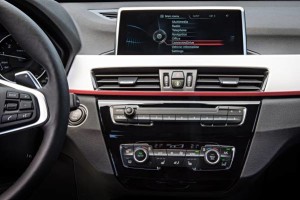
image courtesy BMW
BMW’s display screen isn’t as tall as those of other manufacturers, but it sure is longer. This facilitates split-screen views to show more than one feature at a time.
Drivers determine the contents of the screen using buttons and a controller behind the shift lever.
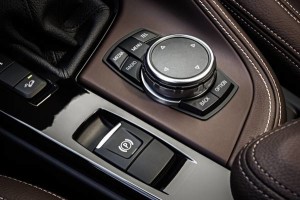
image courtesy BMW
This round controller turns like a knob, moves side to side and up and down like a joystick, acts as a button you can press and – particularly useful when entering addresses in the navigation system – its surface lets drivers draw letters to spell words in their destinations. (This last feature made me nostalgic for the years I used Palm Computing devices.) The surrounding buttons activate commonly used features, like navigation, radio and media.
BMW’s ConnectedDrive services include Concierge Services and, uh, the Internet. For my commentary on offering a fully functional browser in a car, see this review.
Driving
A 2.0-liter TwinTurbo 4-cylinder engine from BMW’s new family of modular engines generates maximum output of 228 horsepower and peak torque of 258 lb-ft.
This power hits the road via the xDrive intelligent all-wheel-drive system, enhanced by the Dynamic Stability Control stability system, BMW’s umbrella term for features like ABS, Dynamic Traction Control, Cornering Brake Control and Start-Off Assistant.
The X1 offers paddle shifters that enable drivers to interact with the new 8-speed Steptronic transmission. BMW set a wider gear spread to keeps engine revolutions lower at higher vehicle speeds, thus reducing emissions.
Moving the vehicle out of a parking spot can trigger beeping from Park Distance Control, going forward or backward. It’s good to know the vehicle is keeping its eyes (or sensors) peeled for me, even though I know I’m not about to scrape the side-view mirror off using the support column next to my parking spot.
The X1 offers three drive modes via the Driving Dynamic Control switch on the centre console.
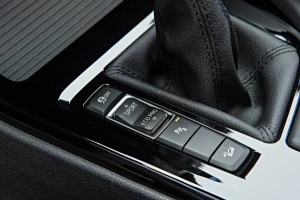
image courtesy BMW
- Sport mode gives the X1’s systems free rein to put out more oomph.
- ECO PRO mode alters the X1’s behaviour in order to help drivers conserve fuel. (Spirited acceleration off the line was available in Eco mode if I wanted it.)
- Normal, the start-up mode, sits between Sport and Eco.
There’s also a “coasting” function. At speeds between 50-160 km/h, the powertrain disengages when drivers take their feet off the accelerator.
Drivers can tailor the behaviour of Sport and ECO PRO drive modes using the Control Display. Regardless of the driving mode chosen, under the right conditions (that is, most of the time) the BMW’s engine quits when the vehicle comes to a stop. The tachometer’s needle sinks to the “Ready” position, going to ‘Off” only when the start/stop engine button is pressed.
Going down steeper-than-average slopes is a little safer thanks to Hill Descent Control (activated using a button near the Dynamic Driving Control switch).
Pricing
The 2016 BMW X1 base model MSRP is $ 38,800. My tester as equipped goes for $50,040.